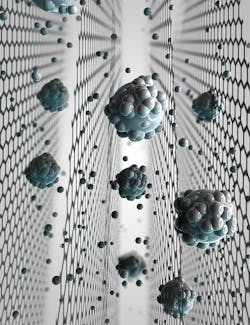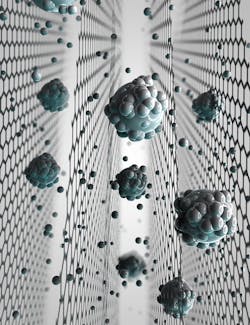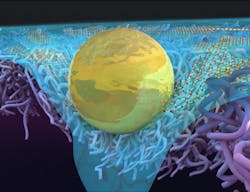Scaling up Graphene Water Filtration Technology
By Andrew Williams
In recent years, the notion of using graphene-based materials for water filtration has gained a lot of traction. So, what types of technology are currently under development? And how suitable is the technology for large-scale water filtration?
One of the early trailblazers in the sector is UK-based outfit G2O, which manufactures a specialised coating that can be applied to existing water filtration membranes. This, the company claims, enables companies to switch easily to a more effective process without incurring significant additional capital expenditure. The material works by coating existing porous materials with a thin layer of graphene oxide that significantly enhances the permeability of filtration materials.
As Tim Harper, chief executive at G20, explains, the creation of a hydrophilic surface on the membrane itself means that it attracts water and “ensures more water that comes into contact with the membrane will pass through”. The spacing between the graphene oxide platelets also acts as a natural filter - meaning that water can pass through the filter ‘while larger contaminant molecules are prevented.
Speaking to WWi magazine, Harper says: “A ‘capillary effect’ also means there is less resistance to water passing through the membrane. This allows more water through while excluding contaminants, therefore making the process more efficient, faster and cheaper through reducing energy.
“It also allows new applications and markets for membranes where their performance is affected by contamination, for example where membrane pores are blocked by oil deposits,” he adds.
Although there has been a lot of interest in creating water filters from graphene and graphene oxide - and plenty of academic work to indicate that it will work - Harper argues that there is a “huge difference between a piece of graphene oxide in a lab and a viable commercial filter”.
Enhanced Permeability
According to Harper, steady progress towards such commercialisation is already being made - and he reveals that laboratory research already carried out, as well further work at scale-up partners the Centre for Process Innovation (CPI), has shown that the coatings work well.
“We have just moved into new labs at the University of Leeds, where we are working with the Water@Leeds group to move from lab testing to pilot plants. We also have partnerships with a number of companies in the oil and gas and consumer goods industries, where we plan to jointly develop pilot plants and further applications,” he says.
“We are planning to have pilot plants in operation next year, and this will allow us to fully quantify the benefits for specific applications, whether this is reduced fouling and maintenance, or less energy inputs required,” he adds.
Ultimately, Harper believes that the key advantages of using graphene in water filtration systems are enhanced permeability, better selectivity and lower cost of ownership. Because the company is focused solely on coating existing filtration media, he also argues that the enhancements are quantifiable - and using a thin layer of graphene enables a large performance increase with a low additional cost.
The chief executive also points out that this enhanced permeability translates into either higher throughput for a given set of conditions, or the ability to reduce the pressure required to operate a system.
“For some applications, this results in enhanced yield, for others it is a major reduction in energy costs. Because we have the ability to control the spacing between the graphene oxide layers we can also create highly selective membranes,” he says.
“Finally, the slight wrinkling of the graphene oxide plates as they are hydrated creates a superoleophobic surface meaning that fouling with oil is not a problem. This opens up new markets for membranes where they have not been used before,” he adds.
Scalability Challenge
Although he is confident about the future commercial potential of the technology, Harper admits that the team must still prove that it works in an industrial environment and that it is scalable. “The first challenge is being addressed by our work with partners on pilot plants, and we have an advisory board consisting of former heads of R&D of a number of UK water utilities to assist us in focusing on the results that matter to the water industry,” he says.
“The coating method was one of the things that attracted me to the technology as I had seen plenty of similar but non-scalable approaches in the past. Our work with CPI concentrates on translating what we achieved in the lab to a scalable industrial process.
“We have a number of options for large scale production and we are focusing on printing as the best way to develop a low cost roll to roll manufacturing method,” he adds.
At present, the main focus is on two main markets, oil-water separation and domestic water treatment.
“In oil-water separation the superoleophobic surface effect allows high throughput applications to be developed which can both enhance the oil yield and reduce the cost of treating the produced water. For domestic water treatment we just announced a new grant from Innovate UK which is helping us to develop a domestic treatment system based on printed membranes,” says Harper.
“This is primarily aimed at markets where people don’t fully trust the quality of their water supply, and the printed filters can remove chemicals, heavy metals and pesticides. The high permeability of the membranes removes the need for additional pressurisation or other treatment,” he adds.
Graphene oxide
Elsewhere, a team of researchers at the University of Manchester is working on another interesting approach to using graphene for water treatment. As Rahul Nair, professor of materials physics at the university, explains, the teams’ research shows that graphene oxide (GO), a chemical derivative of graphene, has a “unique molecular transport property,” meaning that membranes made of GO allow water to permeate but block materials like gases and solvents.
“GO membranes have a laminar structure, and the spacing between GO sheets - typically one nanometre or less - governs the molecular transport properties. Because the spacing between the layers is comparable to the size of salt molecules, salts molecules get blocked by the interlayer channels while allowing water to permeate,” he says.
“Graphene oxide membranes are chemically stable and provide higher water flux and salt rejection, translating to better efficiency of water filtration. Also, the unique sieving mechanism allows the tunability of pore size according to the filtration applications,” he adds.
Despite the lab-based promise, Nair agrees with Harper that the primary challenge for this technology is the scale-up - and he reveals that, even though the technology seems scalable, further research is necessary to optimise the membrane production conditions to fabricate membrane modules for filtration applications.
“In an effort to face up to this challenge, he also confirms that the Manchester team are planning to work with industrial partners to scale-up the technology and are “currently in the process of identifying the correct partners”.
“We are targeting water filtration, including desalination and organic solvent nanofiltration as the applications for this technology,” he adds.
‘Atomic Sieve’
Meanwhile, another research team at the Massachusetts Institute of Technology (MIT) is developing a membrane consisting of a single layer of graphene with nanoscale pores. As Rohit Karnik, associate professor of Mechanical Engineering Microfluidics at the Nanofluidics Research Laboratory at MIT, explains: “It is best to think of the membrane as a sieve at the atomic scale, where all molecules larger than a certain size cannot pass through.”
Although he believes there are numerous uses for graphene-based NATMs (Nanoporous Atomically Thin Membranes) in water filtration systems - such as in the form of adsorbents, graphene oxide or multilayer membranes.
Karnik thinks that the key advantages will be its low resistance to the flow of water and high chemical resistance, coupled with its ability to withstand high pressure and its universal size-based rejection of contaminants. In his view, low resistance to flow will make water purification systems more efficient and compact, an attribute he argues is “especially important if they are to be portable or located in places where space comes at a premium”. He also contends that high chemical resistance may make such membranes easier to clean and maintain, extending the useful membrane life and cutting pre-treatment costs.
“The ability to withstand high pressures may enable systems that have high recovery - that is, those which produce more clean water from the same amount of feed water, or which enable energy-efficient operation at high salt concentrations. This aligns well with the thrust toward zero-discharge systems,” he says.
Because the graphene lattice is rigid, Karnik also believes it may be possible to ensure that molecules above a certain size cannot pass through, in effect assuring ‘universal rejection’ - a property “likely to be very important in the future, where water recycling and reuse will require a number of emerging contaminants to be effectively removed before reuse, which is not possible with today’s membranes”.
“The main challenge, of course, is that graphene NATM is a fairly nascent technology and much R&D work needs to be done. Advances in control of pore size, mitigating leakages, packaging of membranes into modules, and scale-up of manufacture will require time and resources,” he says.
That said, Karnik stresses that Graphene NATMs are a “fairly versatile platform that can be tailored to a multitude of applications in water, chemical separations, bioprocessing, and other applications”.
“I will be surprised if graphene NATMs are not commercialised within the next decade. Water desalination is actually the hardest market, both in terms of technology development and in terms of cost tolerance,” he says.
“The penalty for failure is high, so I expect smaller applications to emerge first, likely in the chemical, biotech, or nanofiltration areas. Once the technology proves itself in these applications, it will open the possibility of designing advanced desalination systems using graphene NATMs,” he adds.
Andrew Williams is a freelance correspondent for WWi magazine.
More Water & WasteWater International Archives Issue Articles



